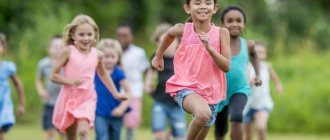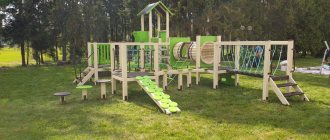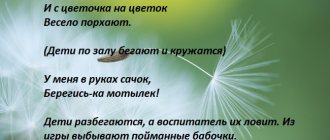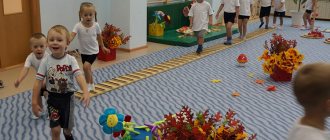Outdoor games for children 3–7 years old with a detailed description of the rules of the game
Maria Balashova (Maleeva)
Outdoor games for children 3–7 years old with a detailed description of the rules of the game
Outdoor games for children 3-7 years old with a detailed description of the rules of the game.
The role of play in the formation and development of a child cannot be overestimated. It is in play that a child learns about the world around him, its laws, and learns to live according to the rules . All children love to move, jump, gallop, and run races. Outdoor games with rules are a conscious , active activity of the child, which is characterized by timely and accurate completion of tasks related to the rules that are mandatory for all participants. Outdoor play is a kind of exercise with which children prepare for life.
• Classification of outdoor games . Outdoor game in the pedagogical process
• Russian folk outdoor games in kindergarten . Implementation of the regional component of the program in preschool educational institutions
• Outdoor games for first grade children (6-7 years old)
Outdoor games are of great importance in a child’s life, as they are an indispensable means for a child to gain knowledge and ideas about the world around him. They also influence the development of thinking, ingenuity, dexterity, dexterity, and moral-volitional qualities. Outdoor games for children strengthen physical health, teach life situations, and help the child receive proper development .
Children of primary preschool age in play, as a rule , imitate everything they see. In children's outdoor games , as a rule , it is not communication with peers that is manifested, but a reflection of the life that adults or animals live. Children at this age enjoy flying like sparrows, jumping like bunnies, flapping their arms like butterflies with wings. Thanks to the developed ability to imitate, most outdoor games of children of primary preschool age have a plot character.
The content of outdoor games for young children 3-4 , 4-5 years old in kindergarten is aimed at developing types of movement: running, jumping, climbing.
• Outdoor game “Mice dance in a circle”
Goal: develop motor activity
Description : before starting the game you need to choose a driver - “cat”
.
The cat chooses a “stove”
(it can be a bench or a chair), sits on it and closes his eyes. All other participants join hands and begin to dance around the cat with the words:
The mice dance in circles
The cat is dozing on the stove.
Quieter than a mouse, don't make noise,
Don't wake up Vaska the cat,
Vaska the cat will wake up -
He’ll break up our round dance!”
While pronouncing the last words, the cat stretches, opens his eyes and begins to chase mice. The caught participant becomes a cat, and the game starts over.
• Game “Sunshine and Rain”
Objectives: to teach children to find their place in the game, navigate in space, develop the ability to perform actions on a signal from the teacher.
Description : Children sit in the hall on chairs. Chairs are their “home”
.After the teacher’s words:
“What good weather, go for a walk!”
, the guys get up and begin to move in any
direction . As soon as the teacher says: “It’s raining, run home!”
, children must run to the chairs and take their place.
The teacher says “Drip – drip – drip!”
Gradually the rain subsides and the teacher says:
“Go for a walk.
The rain has stopped!” .
• Game “Sparrows and the cat”
Objectives: teach children to jump gently , bending their knees, run, dodge the driver, run away, find their place.
Description : Circles are drawn on the ground - “nests”
.
Children - “sparrows”
sit in their
“nests”
on one side of the playground.
On the other side of the site there is a “cat”
.
As soon as the “cat”
falls asleep,
the “sparrows”
fly out onto the road, fly from place to place, looking for crumbs and grains.
The “cat”
wakes up, meows, and runs after the sparrows, which must fly to their nests.
First the role of the “cat”
performed by the teacher, then by one of
the children .
• Outdoor game “Sparrows and a car”
Another game for children 3-5 years old about sparrows.
Objectives: to teach children to run in different directions , to start moving or change it at the leader’s signal, to find their place.
Description : Children are “sparrows”
, sitting in their
“nests” (on the bench)
.
The teacher depicts a “car.”
As soon as the teacher says:
“The sparrows have flown onto the path
,” the children rise from the bench and begin to run around the playground. At the teacher’s signal:
“The car is moving, fly the sparrows to their nests!”
-
the “car”
leaves
the “garage”
, and the children must return to the
“nest” (sit on the bench)
.
The "car"
returns to the
"garage"
.
• Game "Cat and Mice"
There are many games for children with cats and mice involved. Here is one of them.
Objectives: This active children develop the ability to perform movements on a signal. Practice running in different directions .
Description : Children are “mice”
sitting in holes
(on chairs along the wall)
.
In one of the corners of the playground sits a “cat”
- a teacher. The cat falls asleep and the mice scatter around the room. The cat wakes up, meows, and begins to catch mice, which run into their holes and take their places. When all the mice return to their holes, the cat walks through the hall again, then returns to its place and falls asleep.
• Outdoor game for preschoolers “At the Bear in the Forest”
Objectives: develop the speed of reaction to a verbal signal, exercise children in running , develop attention.
Description : Among the participants, one driver is chosen to be the “bear”
.
Draw two circles on the playground. The first circle is the bear's den, the second circle is the home for the rest of the game .
The game begins with the children leaving the house with the words: There is a bear in the forest
I take mushrooms and berries.
But the bear doesn't sleep,
And he growls at us.
As soon as the children said these words, "bear"
runs out of the den and catches
the children . The one who did not have time to reach the house and was caught by the “bear”
becomes the driver (
“bear”
).
• Through the stream ( an active game with jumping )
Objectives: Teach how to jump correctly , walk along a narrow path, and maintain balance.
Description : Two lines are drawn on the site at a distance of 1.5 - 2 meters from one another. At this distance, pebbles are drawn at a certain distance from each other.
The players stand at the line - on the bank of a stream, they must cross (jump over)
over the pebbles without getting your feet wet. Those who stumbled and got their feet wet go to dry them in the sun and sit on a bench. Then they get back into the game.
• Game “Birds and Cat”
Objectives: Learn to follow the rules of the game . React to a signal.
Description : for the game you will need a mask of a cat and birds, and a large circle drawn.
Children stand in a circle on the outside. One child stands in the center of the circle (the cat falls asleep (closes his eyes, and the birds jump into the circle and fly there, pecking at the grains. The cat wakes up and begins to catch the birds, and they run away outside the circle.
• Game “Snowflakes and the Wind”
Tasks: Practice running in different directions , without bumping into each other, act on a signal.
Description : At the signal “Wind!”
children -
“snowflakes”
- run around the playground in different
directions , spinning ( “the wind swirls snowflakes in the air”
).
At the signal “No wind!”
- squat (
“snowflakes fell to the ground”
).
• Outdoor game “Find yourself a partner”
Objectives: to develop in children the ability to perform actions on a signal, to quickly form pairs.
Description : Participants stand along the wall. Each of them receives a flag. As soon as the teacher gives a sign, the children scatter around the playground. After the command “Find yourself a mate”
, participants with flags of the same color are paired up.
An odd number of children must participate in the game and at the end of the game one is left without a pair.
All of these outdoor games can be successfully used for playing in a kindergarten in a group or on a walk. Children of different ages: from 3-year-old children to children of the middle group enjoy playing them.
• Outdoor games for children 5-7 years old
In children 5-6 , 6-7 years old, the nature of play activity changes somewhat. Now they are already beginning to be interested in the result of the outdoor game , they strive to express their feelings, desires, and implement their plans. However, imitativeness and imitation do not disappear and continue to play an important role in the life of an older preschooler. These games can also be played in kindergarten.
• Game "Bear and Bees"
Tasks: practice running, follow the rules of the game .
Description : participants are divided into two teams - “bears”
and
"bees"
.
Before the start of the game, the “bees”
take places in their
“hives” (benches or ladders can serve as hives)
.
At the command of the leader, the “bees”
fly to the meadow for honey, and at this time
the “bears”
climb into
the “hives”
and feast on honey.
Hearing the signal “Bears!”
, all
the “bees”
return to
the “hives”
and
“sting” (salat)
the “bears”
who did not have time to escape .
The next time, the stung “bear”
no longer goes out to get honey, but remains in the den.
• Game "Burners"
Tasks: practice running, respond to a signal, follow the rules of the game .
Description children take part in the game , who become pairs and hold hands. In front of the column there is a driver who looks forward. The children repeat the words in chorus:
Burn, burn clearly
So that it doesn't go out,
Look at the sky -
Birds are flying
The bells are ringing!
Once! Two! Three! Run!
As soon as the participants say the word “Run!”
those standing in the last pair in the column release their hands and run forward along the column, one on the
right side , the other on the left.
Their task is to run forward, stand in front of the driver and join hands again. The driver, in turn, must catch one of this pair before they hold hands. If you manage to catch, then the driver and the caught one will form a new pair, and the participant left without a pair will now lead. • Outdoor game “Two Frosts”
A well-known game for preschoolers with simple rules . Objectives: to develop inhibition in children , the ability to act on a signal, and practice running.
Description : On opposite sides of the site there are two houses, indicated by lines. Players are placed on one side of the court. The teacher selects two people who will become drivers. They are located in the middle of the area between the houses, facing the children. These are two Frosts - Red Nose Frost and Blue Nose Frost. At the teacher’s signal “Start!”
both Frosts say the words: “We are two young brothers, two frosts are daring.
I am Frost Red Nose. I am Frost Blue Nose. Which of you will decide to set out on the path?” All the players answer: “We are not afraid of threats and we are not afraid of frost”
and run to the house on the opposite side of the site, and Frosts try to freeze them, that is, touch them with their hands. Those of the guys who were touched by Frost freeze in place and remain like that until the end of the run. The frozen ones are counted, after which they join the players.
• Game "Sly Fox"
Goal: to develop agility, speed, coordination.
Description : A line is drawn on one side of the site, thereby indicating the “Fox House”
.
The teacher asks the children , who are located in a circle, to close their eyes. the formed circle behind and touches one of the participants, who from that moment becomes a “sly fox
.
After this, the teacher invites the children to open their eyes and, looking around, try to determine who the sly fox is. Then the children ask 3 times: “Sly fox, where are you?”
.
At the same time, the questioners look at each other. After the children have asked the third time, the sly fox jumps into the middle of the circle, raises his hands up and shouts: “I’m here!”
.
All participants scatter around the site in all directions, and the sly fox tries to catch someone. After 2-3 people are caught, the teacher says: “In a circle!”
and the game starts again.
• Game “Deer Catching”
Objectives: practice running in different directions , agility.
Description : Two shepherds are selected from among the participants. The remaining players are deer located inside the outlined circle. The shepherds are behind the circle, opposite each other. At the leader’s signal, the shepherds take turns throwing the ball at the deer, who try to dodge the ball. The deer that the ball hit is considered caught and leaves the circle. After several repetitions, he counts the number of deer caught.
• Game "Fishing Rod"
Objectives: develop dexterity, attention, speed of reaction.
Description : participants are located in a circle. In the center there is a driver - a teacher. He holds a string in his hands, at the end of which a small bag of sand is tied. The driver rotates the rope in a circle just above the ground. Children jump in such a way that the rope does not touch their legs. Those participants whose legs are hit by the rope are eliminated from the game .
• Game “Hunters and Falcons”
Tasks: practice running.
Description : All participants - falcons - are on one side of the hall. There are two hunters in the middle of the hall. As soon as the teacher gives the signal: “Falcons, fly!”
participants must run to the opposite side of the hall.
The hunters' task is to catch (spot)
as many falcons as possible before they have time to cross the conditional line. Repeat the game 2-3 times, then change the drivers.
• Game "Spider and Flies"
Objectives: to develop in children the ability to perform actions on a signal.
Description : in one of the corners of the hall, a circle indicates a web in which there is a spider - the driver. All the other guys are flies. All flies "fly"
around the hall, buzzing.
At the presenter’s signal “Spider!”
the flies freeze. The spider comes out of hiding and carefully examines all the flies. He takes those who move into his web. After two or three repetitions, the number of flies caught is counted.
• Outdoor game “Mousetrap”
Objectives: to develop in children the ability to perform actions on a signal.
Description : Two participants stand facing each other, join their hands and raise them higher. After this, both say in unison:
“How tired we are of the mice, they gnawed everything, ate everything!
We’ll set up a mousetrap and then we’ll catch the mice!”
While the participants are saying these words, the rest of the guys must run under their clasped hands. At the last words, the presenters abruptly lower their hands and catch one of the participants. The caught one joins the catchers and now there are three of them. So the mousetrap gradually grows. The last participant remaining is the winner.
ELEMENTARY GAMES include
· Story games
have a ready-made plot and firmly fixed rules, game actions are associated with the development of the plot and the role played by the child.
These games are mainly collective. The plot ones include: folk round dance games (with singing and recitative): “Boyars”, “Pebble”, “Terera”, “Golden Gate”, “Goat”, “And we sowed millet”, “Stream” and folk games without singing: “Cat and mouse", "Ring", etc.
· Plotless games
contain motor game tasks that are interesting for children, leading to achieving the game goal. These include:
— games such as dashes and traps
(do not have a plot, images, but have rules, a role, game actions):
“Colors”, “Tag”
- games with elements of competition
(individual and group): “
Blind Man’s Bluff”, “Third Wheel”, “Empty Space”
- relay games
(conducted with division into teams, each player strives to complete the task in order to improve the team’s result)
— games using objects
(skittles, serso, ring throw, balls) require certain conditions, the rules in them are aimed at the order of arrangement of objects, their use, the order of actions and the element of competition)
— amusement games
— in them, motor tasks are performed in unusual conditions, often include an element of competition, relay races:
“Running with tied legs together,” “Swamp,” “Fish,” “Coiling a rope.”
COMPLEX ones include
sports games (small towns, badminton, table tennis, basketball, volleyball, football, etc.), which require composure, organization, observation, development of movement techniques, and speed of reaction. Depending on the age of the children, they can play according to simplified rules (including in groups of different ages).
According to the degree of load, outdoor games are divided into
| High mobility games | Medium mobility games | Low mobility games |
| The whole group of children participates at the same time; leading movements are running and jumping. | The whole group actively participates, but the nature of the movements of the players is relatively calm or the movement is performed by subgroups. Leading movements are walking, passing objects. | The movements are performed at a slow pace, and their intensity is insignificant. The leading movement is walking + attention games. |
Counting rhymes are used to select presenters and divide players into teams in outdoor games.
and
drawing lots
. You can use folk or original works of these genres, as well as invent them yourself (for the plot of the game or solving a specific educational problem associated with a specific group) and together with the children.
Stages of an outdoor game:
— preparation of the game by the teacher himself (thinking through the rules and their explanations, learning texts, preparing equipment and materials)
— children’s emotional mood for the game
- precise, concise explanation of the rules that interests children
- playing a game with the obligatory participation of a teacher (as a presenter, driver or “captain” of the group - depending on whose task in this game is more difficult)
— 2-3 repetitions of the game in one lesson
- inviting children to choose their favorite games from a well-known repertoire and reinforcing the game in subsequent lessons by reminding them of the basic rules
- introducing new variants of the game based on what is already well known (including inventing variants of the game together with children - for example, let it not be “Cat and Mice”, but “Tom and Jerry” or “Wolf and Hares” - then the text speech accompaniment, and the nature of movements will definitely change!)
Shaggy dog
The purpose of this game is to instill in children endurance, the ability to overcome their shyness and follow some basic rules. The game situation is of a plot nature: it creates an image of a character who needs to be feared. The child’s task is that he must meet this danger and not run away from it until a certain signal. Thus, the game teaches children to manage their behavior.
It is carried out as follows. The teacher draws a circle on the ground. This is the home of the shaggy dog. At a distance of 2-3 steps from him, a line is drawn that children must reach. From this line, at a distance of 15-20 steps, a second line is drawn, where the children will escape from the shaggy dog. One of the children is assigned the role of a shaggy dog - he goes to his house and waits for the children to come to him. The teacher brings the children to the edge of their house and lines them up. First, the teacher herself leads the line of children, setting the direction and pace of movement, and says the following words, which all the children repeat with her:
Here sits a shaggy dog
With your nose buried in your paws.
Quietly, quietly he sits,
Either dozing or sleeping.
Let's go to him and wake him up
And let's see, something will happen!?...
Under this text, all the children, holding hands, creep up to the line next to the dog’s house. On the last two lines they reach out and touch him. The dog should not move at this time: sitting with his eyes closed, he allows himself to be stroked. Suddenly, unexpectedly for the children, the dog opens his eyes and barks, and the kids run away into their house (beyond the line). The dog runs after the children, barks at them, and when everyone runs away over the line, he returns to his house. Each child chosen for this role performs it no more than two times, after which a new dog is chosen.
Despite the entertaining and seemingly primitive nature of this game, it contains certain rules that are not so easy for three-year-olds to follow:
- do not touch the dog until the text ends;
- the dog does not move and does not open his eyes until he is touched;
- You can run to your house and save yourself only after the dog barks.
Following these rules teaches children self-control and organized behavior in a group.
11.
Methodology for conducting a physical education festival.
1. Judging. Particular attention is paid to the training of judges. The panel of judges includes: the head teacher, senior teacher, teachers of groups taking part in the holiday, parents who are interested in participating in the holiday. At the council of the panel of judges, the meeting, the requirements for performing various numbers of the holiday should be discussed, evaluation criteria should be determined taking into account the age characteristics of the participants in the holiday. As practice shows, the most correct way is to evaluate children’s achievements not by a point system, but by the quality of performance of various motor actions included in the holiday program, as well as the manifestation of the physical qualities of speed, dexterity, good coordination of movements and orientation in space. Members of the panel of judges must be attentive, friendly, and objective. When summing up. When analyzing the results achieved in team competitions, games, and relay races, it is necessary to take into account the individual data and capabilities of each person, to note the diligence and honest implementation of the rules by children. It is important to take care of maintaining friendly relations in the team, to prevent cases of disrespect, hostile attitude towards a friend, and arrogance. 2. Holding a holiday. On the day of the holiday, everything should be ready for it. Colorful design of places for performances, games, and competitions that corresponds to the theme of the holiday should evoke joyful anticipation of the holiday in children. The entire staff of the preschool institution takes an active part in this. The holiday must begin exactly at the appointed time. It is important to create a good, calm environment and not allow disruption to the children’s routine. For this purpose. Physical education holidays are most often held in the afternoon (during the time period from 15.30 to 16.10). This is especially important for their organization in winter (taking into account the length of daylight hours). Attentive attitude towards each child from the kindergarten peers, maintaining a joyful mood, providing the necessary assistance in changing into festive costumes - all this helps children to feel confident and calm. 3. Host of the holiday. The host plays an important role during the celebration. They can be an experienced teacher, a senior teacher, or one of the parents or bosses. The success of the holiday largely depends on the host. He must know well the script of the holiday, the sequence of speeches of all participants, be able to briefly and clearly explain tasks for teams and individual speakers, be active, resourceful, and quickly resolve unforeseen situations. The presenter must be well aware of the characteristics of preschool children, be able to distribute attention, and see children’s reactions to victory and defeat in games, relay races, and attractions. It is very important to cheer up a low-active child in a timely manner and involve him in the performance along with everyone else. Throughout the entire holiday, it is necessary to activate each participant as much as possible, including not leaving without attention the children present at the holiday as spectators, using a moment of humor for this. In the process of managing the course of the holiday, it is mandatory to maintain contacts between the presenter and the panel of judges and coordinated joint actions with it. The celebration must not be allowed to prolong too much. This can lead to overwork of children, loss of interest in what is happening and, as a consequence, violation of discipline. It is important that the actions at the festival change continuously, there should be no pauses between performances, or long periods of thinking over the judges’ scores. The holiday should create an upbeat mood, the maintenance of which depends on the host. 4. Summing up and rewarding. A good impression of the holiday is created at its organizational completion, summing up, and awarding the participants. It is necessary to think in advance about the form of rewarding children for doing exercises well, taking precedence in relay races, resourcefulness and dexterity demonstrated in attractions and fun games. It is important that there are no losers at the holiday, so that every child feels happy from participating in it. It is good if the winners are awarded, taking into account such mottos as “Everyone wins - no one loses”, “The main thing is not victory, but participation”, “Friendship wins”. Awards and signs of attention can be different: commemorative medals, pennants, badges, diplomas, emblems are used differently. Thus, the winners in each individual type of competition are awarded medals immediately after they are held, the rest of the children (participants of the holiday) at the end of all types of competitions receive commemorative medals (souvenirs). Collective rewards (for the whole team, group) are the most educationally appropriate. They help unite children and instill in them a sense of friendship and collectivism. The winning team can be rewarded by being the first to take a lap of honor and being entrusted with lowering the competition flag. At the next physical education festival (at its opening), the team raises the flag. At a festival where family teams participate (each competition is evaluated, awards can be for victory both in individual competitions and for the team’s victory. The following forms of encouragement are provided: children’s results in individual exercises (movements) are reflected on the competition screen, winning teams are awarded diplomas , teams participating in the holiday receive memorable pennants. Awarding the winners and participants can be the most unexpected. Thus, a song or dance is performed in honor of the winners, children participating receive sweet prizes (they can also be awarded a variety of medals of their own making). Children of primary preschool age are presented flowers to the winners. It is also necessary to note not only children, but also adults who took an active part in preparing and holding the holiday. Children share their impressions of the holiday in conversations with adults, independently repeat certain exercises, games, relay races. The episodes of the holiday they liked are reflected in drawings, modeling and applications. Adults should be attentive to the emotional experiences of children associated with the holiday, maintain an interested attitude towards physical education and sports, and do their best to encourage children to participate in healthy active recreation.
Physical education.
Physical education is one of the most effective forms of active recreation. Its content consists of physical exercises, which are carried out in the form of fun games, fun, and entertainment. Exercises performed with emotional upliftment have a beneficial effect on the child’s body. During physical education, children’s motor skills are consolidated and motor qualities (speed, dexterity, spatial orientation, etc.) are developed. Physical education leisure activities contribute to the development of a sense of collectivism, camaraderie, friendship, mutual assistance, develop endurance and attention, dedication, courage, perseverance, discipline and organization.






